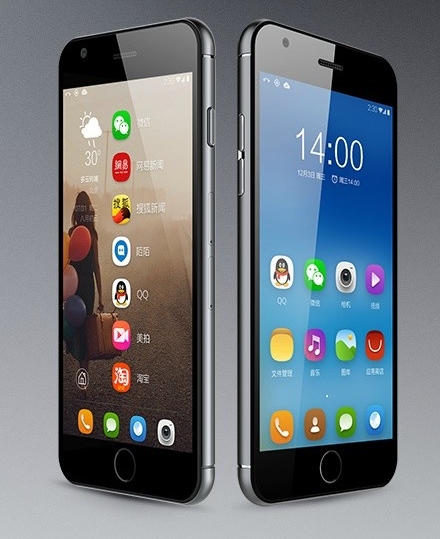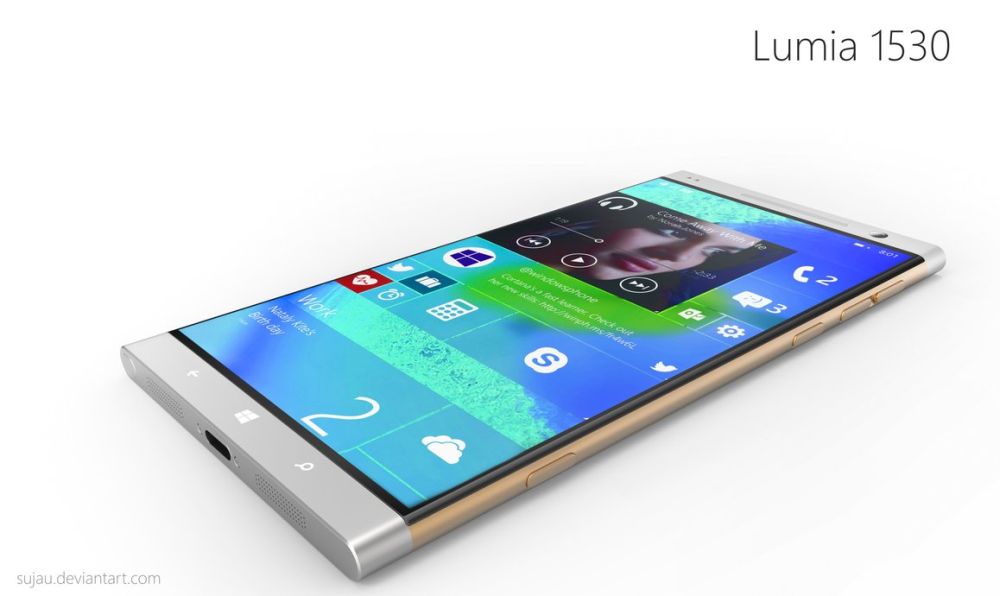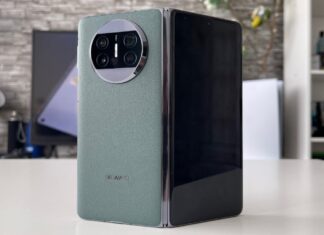How can you make a phone that’s both compact and very long for its diagonal? Only Sony knows the answer to that question and thus the Xperia XA1 was born. We had only good things to say about the Sony Xperia XA1 Ultra, which we previously tested and now it’s time for the Xperia XA1 to get the same treatment. The Xperia XA was an excellent midrange device, so expectations were high for the newcomer. The Sony Xperia XA1 is priced at around $300 and it’s available in white, black, gold or pink.
It was unveiled at MWC 2017 this Spring, with the Xperia XA1 Ultra and it adopts the same edge to edge approach, with very narrow side bezels and larger top and bottom areas. This 5 incher is very long for modern standards, but somehow remains rather compact and comfy. It’s got small buttons, with good feedback and sticks to the angular Xperia design we’ve known for such a long time.
It measures 8 mm in thickness, weighs 143 grams and when compared to the Xperia XA it’s 6 grams heavier and 0.1 mm thicker. It’s also thicker than the Huawei Nova and 3 grams lighter. The side bezels, which are ultra narrow look amazing and give the device an unique vibe. The top and bottom are oversized, but that’s quite useful, since you can grip the device better when watching videos or playing games.
The build is quite solid and the handset is made of polycarbonate and metal. The approach is very minimalistic and the back is easily smudged and easy to scratch. The side tray is also easy to pull off and access the slots. The design is fine for Sony fans, but this time around it may also attract non Sony fans. Time to talk about the display, a 5 inch IPS LCD with a 16:9 aspect and a 1280 x 720 pixel resolution.
There’s also Gorilla Glass protection, by the way. The viewing experience is immersive and the image was very crisp, bright, plus the view angles were wide. Colors were great and the contrast wasn’t bad. Pixels have an RGB Stripes arrangement and the luxmeter showed us a value of 472 LUX, which is good, but this is no Xperia XA1 Ultra, that scores 611 LUX.
We scored above the Moto G5 and Huawei P10 Lite, but below the Sony Xperia X Compact and Huawei P9 Lite 2017. The Settings include options for brightness, adaptive brightness, Smart Backlight Control and Image Enhancement. There’s also a Super Vivid Mode and white balance options with RGB sliders. Font size and display size can also be tweaked here.
It’s a good display overall, but I wish it offered Full HD resolution. Time to dissect the rest of the hardware! We get an octa core MediaTek Helio P20 processor here, clocked at 2.3 GHz, an upgrade from the Helio P10 from the XA. There’s also 3 GB of RAM here, 32 GB of storage, a microSD card slot and in spite of the pretty good midrange specs, we did hit some lag.
It appears especially when you’re using the camera for a longer time. Riptide GP Renegade runs OK, with zero lag and problems and the graphics look hot. As far as benchmarks go, we scored well in Quadrant, above the HTC 10 and OnePlus 3, but below the Galaxy S7 Edge. In AnTuTu 6 we scored above the Huawei P10 Lite and Motorola Moto M, but below the Lenovo Vibe X3 and LG Nexus 5X.
In 3DMark Ice Storm Unlimited we scored above the LG G Flex and the Huawei Honor 7, but also below the quite old Xperia Z3 and Huawei Nova Plus. Another relevant test is the GeekBench 4 multi core one, where the Xperia XA1 scored above the Xperia X Performance, so not bad overall. As far as temperature goes, we scored 39.1 degrees Celsius after running GFXBench and also 39.1 degrees when running Riptide GP Renegade.
It’s close to the overheating limit, but not quite there, so it’s OK. Keep in mind that in the very hot summer sun, the device can get a bit too hot. On the battery front, there’s a 2300 mAh battery of the Li-Ion variety (8.7 Wh) and support for Qnovo Adaptive Charging and MediaTek Pump Express 2.0. We did a video playback test and achieved 10 hours and 28 minutes, which is quite good and superior to the Sony Xperia XZ Premium for example, as well as the LG G5.
We scored below the Galaxy S6 Edge and iPhone 6 though. In PCMark we got to 7 hours and 47 minutes, which is quite good and superior to the Xiaomi Mi 5 and Motorola Moto G5. We also scored below the Lenovo Vibe X3 and Nubia N1. Charging is done in 2 hours and 38 minutes, a bit on the long side, but reasonable for a midrange phone. It’s better than the Amazon Fire Phone, at least.
By the way, if you’re wondering about charging done in steps, after 5 minutes we were at 2% and after 15 minutes at 12%. 30 minutes meant 27% and 1 hour 55%. Settings include a Stamina Mode and Ultra Stamina Mode, with the latter letting you use only the most basic apps, while the former will shut down some functions and stuff running in the background.
Overall a good battery for the $300 segment. Time to see what the speaker is capable of. At first sight I thought that those two front slits actually hid speakers. Well, turns out that there’s only one speaker at the bottom. The music player is the spiritual successor to Walkman and brings Spotify integration, as well as the usual huge array of options, ranging from Clear Audio+ and Dynamic Normalizer to the EQ. That one has 5 custom channels, genre settings, Clear Bass and then there’s also Surround and Xloud, which you can actually feel, since the volume gets louder.
Special Sony headphone options are also included. Now the actual listening experience involved a pretty loud volume, but also a bit metallic at top level. There was no big distortion, no back vibration and the bass was quite punchy, plus the highs were well rendered. We didn’t get headphones bundled with the phone, but we did get FM radio.
We also did a decibelmeter test and achieved 86.1 dBA at the front and back using our typical audio sample and surpassing the Moto G5 and HTC U11 with these values, but scoring below the Huawei Mate 9. That was audio and in games like Riptide we got to a very high 97.5 dBA, which is very good too and superior to the Galaxy S8 and Huawei P10 Plus.
It also scores below the HTC U Ultra and overall we totally dug the acoustics. Leaving this behind, I guess it’s now time to focus on the cameras. We get a 23 megapixel back shooter with Exmor RS sensor and hybrid autofocus, as well as F/2.0 aperture, Steadyshot tech and 5x clear image zoom. Then there’s the 8 MP front camera with Steadyshot as well and F/2.0 aperture.
The Camera app starts up fast and the cam itself is pretty snappy with the focus speed, but a bit sluggish in picture taking. Options are straight forward, with stuff like Superior Auto, Manual, Video and the Apps being here. There’s white balance, ISO, focus and shutter. Then there’s HDR and also object tracking, AR and Panorama. Now that we’re done with all those options, let’s see the gallery of shots we took.
First of all, we had to deal with a very sunny day (gallery here) and we achieved great details and a nice landscape capture. Focus was excellent in precision and the selfie cam was very well behaved, with excellent clarity, texture of the skin and colors. Back to the main cam, it had a tendency to burn the hues of green, just like the Xperia XA1 Ultra actually.
In general the other colors were quite vivid, but not oversaturated. Brightness was nice and closeups looked great, so we pulled off some flower macros. HDR is a bit too vivid and bright in my book and yes, we did encounter some burnt shots. I loved the way the camera was able to focus, especially close up, something rare to be said about an Xperia.
It also handles close up focusing better than the Xperia XA1 Ultra. I feel that the tendency is to slightly over sharpen things sometimes like the Galaxy A models from Samsung, but not in a major way though. It feels a lot like the midrange, lots of a pixels quality of the Lenovo Vibe X3 to be honest. It also fights the ZenFone 3 or eve the ZenFone 3 Deluxe in equal leagues and it’s a solid Xperia XA successor.
Low light captures revealed one of the best flashes I’ve ever seen on a phone. Clarity and brightness were top notch all around, but things dropped when zooming in. Yes, this handset’s capture is a bit darker at night compared to other phones, but at least the clarity and colors were OK. We had a nice texture of the flowers and buildings and this is certainly one of the good ones.
There’s no blue or yellow hue to spoil the party, but we did see some blur every now and then and it even snuck into some of the day time shots. I’d put on par with a Galaxy A5 (2017) and maybe a bit better than the Huawei P10 Lite and P9 Lite 2017. On the video capture front, we played with Full HD MP4 video capture, at 30 FPS and 17 Mbps. The result is a blurry video capture, with a surreal sky and slow zoom.
Clarity and colors were quite good, focus was OK and the exposure change handled the switch between a sunny and shadowy scenery fine. The microphone was all OK for ambiance, minus the winy parts. HDR is kinda useless, since it tends to make the capture too yellow. The stabilization is fine here, especially for a midranger. Good filming overall and I have to highlight the stabilization that would even flatter a flagship.
Object tracking is solid, there’s some refocusing and all in all a great piece of video. The only problem here if we can call it that is the Xperia XA also took great videos, but it calibrated colors in worse fashion. Low light videos brought on OK brightness, some refocusing and a grainy image when zooming in. The mic is not bad, the colors are reasonably calibrated and we saw some image flicker when moving around.
The halos are big and the image is a bit yellow. There’s less blue and yellow here compared to other phones and compared to previous Xperias, it does fine. I’d put on par with the Huawei P10 Lite and Huawei P9 Lite 2017. We also messed around with the web browser preinstalled here and it’s Chrome we’re talking about. It’s offering a mid level speed and midrange benchmarks.
The input is done via Swiftkey and Swype is also in the mix. On the connectivity front, there’s a single SIM and a dual SIM version, both with nano SIM card slots. 4G LTE Category 6 is also here, plus GPS, Glonass, Google Cast, WiFi and Miracast. Bluetooth 4.2 and USB Type-C complete the list, so it’s all modern. Calls are loud and clear and the SpeedTest revealed a 106 Mbps download speed via 4G and 47 Mbps in upload.
During WiFi testing we got to 76 Mbps in download and 25 Mbps in upload. On the OS and UI front, there’s Android 7.0 Nougat here with the typical and latest Xperia UI on top. That’s glossy and fancy, with a slight PlayStation UI vibe. There are a lot of side menus and lots of transparency. Multitasking is done via carousel and the leftmost homescreen is basically the Google Now window. If you keep the homescreen pressed, you can trigger the widgets, wallpapers, themes and icon pack and transition options.
The dropdown portion includes notifications and Quick Settings, while the actual Settings are pretty basic, focused on connectivity, audio, display, security, storage and memory. There’s no fingerprint scanner here, sadly. The preinstalled apps list includes 43 apps, which is quite a lot, but the good thing is that many of them are uninstallable easily. There’s PlayStation, News, Movie Creator, Sketch, Spotify, Amazon and AVG.
And now it’s time for the verdict!
Here are the Pros:
- good looking phone
- good display
- OK benchmarks
- good battery
- pretty solid camera details and selfies
- nice closeups and low light capture
- OK stabilization
- Nougat and uninstallable apps
And the Cons:
- too long maybe for some people
- some lag
- burnt green hues in photos
- no fingerprint scanner
- no waterproofing
- no stereo speakers
- not a bit video capture upgrade from Xperia XA
Sony Xperia XA1 is a proper midranger, with a proper pricing, the ideal type of phone for someone who wants a flagship, but he/she is not ready to spend a whole paycheck or even half of it on it. It’s a great phone for pics and selfies, games even and it has the cool vibe of an edge to edge handset, with ultra narrow bezels. It’s a very solid Hawei P10 Lite, albeit a smaller screen one.
It can also fight the ZenFone 3 tooth and nail. The device can be bought here.


















































































